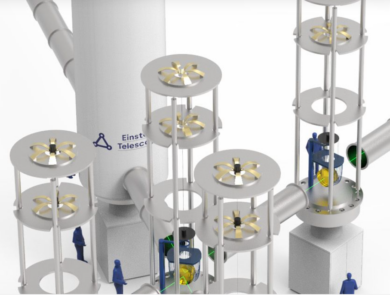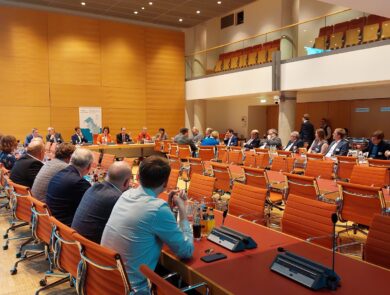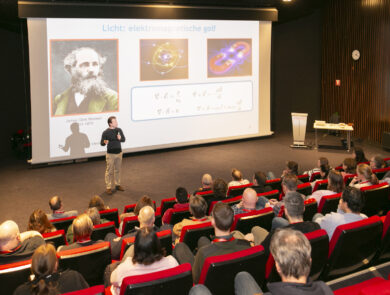Science and industry team up in project ‘Einstein Telescope Technologies’

There are a lot of studies and projects going on to prepare the border area of Belgium, Germany and the Netherlands for the Einstein Telescope. The newest project is Einstein Telescope Technologies (ETT): a project focusing on developing the required technology, subsurface studies and spinoff to other sectors. The project officially kicked off in November 2021, and will run until the end of 2023. It is carried out by a consortium of 12 knowledge institutes and companies. How does this project add to the other projects and preparations? And why is it important to cooperate with industry? Prof. Stefan Hild explains.
What is the Einstein Telescope Technologies project about?
In this project we have bundled some of the most tricky challenges of the Einstein Telescope. Questions like: How to construct the large underground domes and caverns that we need a few hundred meters under the earth surface? Are there ways to construct a suitable vacuum system with innovative and more cost effective concepts? And how can we cool down a mirror without introducing additional noise, keeping the mirror’s motion as low as a fraction of the size of an atom?
Sounds fascinating, gravitational wave technology…
Absolutely! Gravitational wave observatories are some of the most complex instruments humankind has ever constructed. After Albert Einstein predicted the existence of gravitational waves, it took another 100 years until we actually had machines that were sensitive enough to measure them. Now we are pushing to get to the next game changer, the Einstein Telescope. I personally love the complexity and beauty of the technologies we need.
There are also other projects to prepare the region for the Einstein Telescope, like ETpathfinder, E-TEST and ET2SMEs. How does the ETT project relate to this?
I think Einstein Telescope Technologies, or ETT, is a natural next step that adds to the ETpathfinder and E-TEST projects. In particular I would hope that several of the aspects that we plan to develop in ETT will make it at some point into ETpathfinder. Like for instance cooling strategies. Or maybe we can also test a new type of vacuum tube in ETpathfinder in the coming years.
The ET2SMEs project has a different focus: it helps small and medium enterprises and other companies to benefit from the Einstein Telescope. That project focuses on the extended Euregio Meuse-Rhine. In the ETT project we collaborate with industry on a national level in the Netherlands. This will feed back into what we hope to achieve with ET2SMEs. In short: all projects and activities are connected and complementary.
What do you think will be the main outcomes of the ETT project?
One the one hand I hope we will develop new technologies. Like for instance techniques to cool mirrors without introducing vibrations. Or new algorithms to analyse the huge amount of signals from the Einstein Telescope in the most efficient way. Also finding new and more cost effective ways to build the largest vacuum system in the world would really be a big step forward.
On the other hand ETT allows the industry partners to familiarize themselves already with the requirements and concepts needed for Einstein Telescope. This will help them to be prepared in the future, when the huge contracts for the initial construction will be awarded.
How about technological spinoff?
I definitely hope there will be lots of knowledge transfer from ETT to other interesting applications. Let’s take the vacuum system research as an example: here we try to reduce the cost of large vacuum systems as well as trying to reduce the leakiness for hydrogen. Being able to build vacuum systems in a more cost-effective way would help for instance the hyperloop project. Developing vacuum system coatings which reduce leakiness for hydrogen could have an immediate application in hydrogen cars or other parts of an hydrogen economy.
How has industry been involved in the Einstein Telescope so far?
Mainly via smaller contracts and tenders for ETpathfinder and E-TEST. For example building a cleanroom and building the ETpathfinder vacuum system. There we already got a glimpse of the excellent capabilities of companies. But this was just simply carrying out projects that we as scientists had designed beforehand. ETT takes us to a new stage of collaboration, where industry and researchers can engage in true co-development of technologies and combine their creative ideas and all their existing expertise.
Why is it necessary, cooperating with industry?
Without industry it would be impossible to build the Einstein Telescope. Building R&D labs is one thing, building a 1.9 billion Euro research infrastructure is of a completely different scale. Here we need to build on expertise in construction of civil infrastructures of a similar scale. This includes systems engineering, professional project management, risk mitigation etc. Industry is really where such expertise sits. Only if researchers and industry team up, we can make the Einstein Telescope a success.
Also whenever you push boundaries in fundamental science there turn out to be interesting spin-offs that have much wider applications. For instance: in gravitational wave research we have worked on ways to stabilize lasers. That technology is now being used to make our clocks more accurate. Another example: some of my colleagues in Glasgow have used gravitational wave techniques to create artificial bones via triggered stem cell differentiation. And other colleagues have developed new gravity sensors, which may allow for early warning of earthquakes and tsunamis.
Are there any challenges in cooperating with industry?
The real challenge is to create synergies and win-win situations for everyone involved. In particular for industry partners it is hard to engage with the Einstein Telescope before the real construction money becomes available. However, once the budget is there, ideally industry has already been preparing for the specific requirements and has collected experience in specific technologies. So, here we have a problem, but ETT is a great opportunity to circumvent exactly this problem.
Read more:


